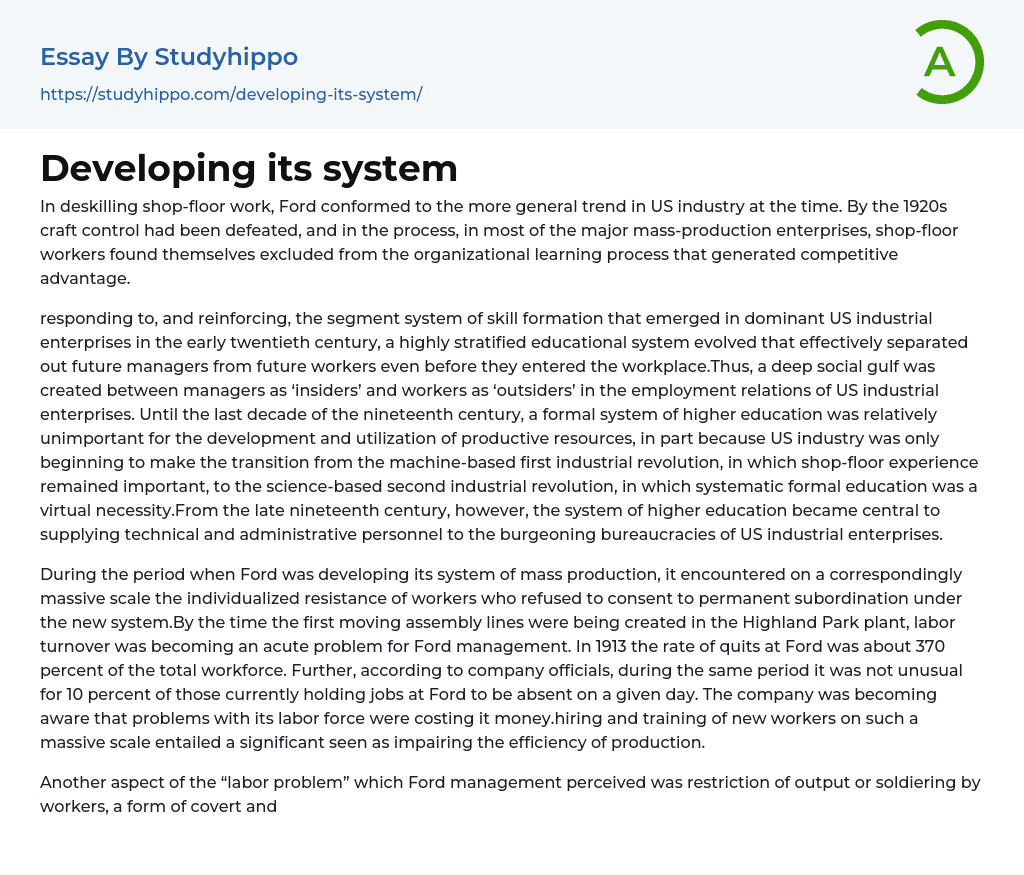Ford's decision to deskull shop-floor work was in alignment with the prevailing trend in American industry during that period. The downfall of craft control had already taken place by the 1920s, resulting in the exclusion of shop-floor workers from the organizational learning process which generated competitive advantage in most major mass-production enterprises.
The early twentieth century saw the emergence of a skill formation system in dominant US industrial enterprises, which spawned a highly stratified educational system. This effectively segregated future managers from future workers even before they entered the workforce. Consequently, a significant social divide was created between managers and workers in US industrial enterprises. Until the late nineteenth century, a formal system of higher education held little importance for productive resource development and utilization. This was due in part to the developing US i
...ndustry transitioning from the machine-based first industrial revolution, in which shop-floor experience held sway, to the science-based second industrial revolution, where formal education was crucial. Soon after, however, higher education became essential to supply technical and administrative personnel to burgeoning bureaucracies in US industrial enterprises.
During the development of Ford's mass production system, workers resisted the new system on a large scale. This led to a high rate of labor turnover and absenteeism, which cost the company money. By 1913, the rate of quits at Ford was about 370% of the total workforce, and 10% of workers were absent on any given day. The hiring and training of new workers on a massive scale was seen as impairing production efficiency.
The restriction of output by workers was seen as another aspect of the "labor problem" by Ford management. This covert and informal resistance challenged
the idea of management control and directly opposed the principles of Taylorism and Fordism. While flow production and moving line assembly had reduced soldiering, it still remained a concern. Moreover, Ford management was worried about more organized forms of opposition and the potential influence of unions like the Carriage, Wagon and Automobile Workers' Union (CWAWU) and radical groups such as the International Workers of the World (IWW) on its workers. Although Detroit had been known as an open-shop town since 1902 with weak labor unions and radical organizations, IWW had launched a highly-publicized campaign to organize auto workers in Detroit. It agitated Ford's Highland Park plant and led a strike that was organized along industrial lines, making it even more frightening for employers. Additionally, Ford faced labor control issues due to the high number of immigrants in its new industrial workforce.
In 1914, over 70% of the workers at Ford were foreign-born, with at least 22 nationalities represented. Eastern and southern Europeans were the most common. Many of these workers came from a peasant background and found the industrial work culture at Ford to be entirely unfamiliar. Despite the division of labor and machinery at Ford minimizing the need for skill, managers worried about the implications of a culturally diverse workforce on shop discipline and productivity. To address this, Ford aimed to create a collective vision where unskilled immigrant workers could identify with American values and engage in voluntary cooperation with management for mutual success. This partnership would enable individuals to succeed based on their abilities, becoming property owners and even investors.
According to Banas and Sauers' (1988) report, Ford's policies aimed to provide workers with
the benefits of liberal capitalism and its protection of individual rights and private property, thus promoting a common American identity centered on abstract individualism. This approach was reflected in the company's emphasis on participative management and employee involvement.
Banas, P. and Sauers, R. explored the association between participative management and employee involvement at Ford Motor Company in Dearborn in 1989. Meanwhile, Darlington, R. delved into workplace unionism dynamics in London and published a book under Mansell in 1994.
McGraw-Hill published Legge's Power, Innovation and Problem-solving in Personnel Management in London in 1978. Starkey and Mckinlay are also authors in the field.
The book, "Strategy and the Human Resource" by Oxford Blackwell, was published in 1993. In 1989, K. Starkey and A. McKinlay wrote an article titled "Beyond Fordism? Strategic Choice and Labor Relations in Ford UK" that appeared in the Industrial Relations Journal (20(2), 93-100). Additionally, there is a program called Turu that offers Employee Development and Assistance.
Oxford's Ruskin published a work in 1991, while Turu's study on employee participation and non-participation in EDAP was conducted in 1993.
- Rabbit essays
- Distribution essays
- Large Animals essays
- Mouse essays
- Poultry essays
- Animal Abuse essays
- Cats Vs Dogs essays
- Cattle essays
- Territory essays
- Culture essays
- Social Control essays
- Citizenship essays
- Social Justice essays
- Caste System essays
- Social Responsibility essays
- Socialization essays
- Deviance essays
- Modern Society essays
- Popularity essays
- Civil Society essays
- Community essays
- Female essays
- Filipino People essays
- Igbo People essays
- Indigenous Australians essays
- Indigenous Peoples essays
- Minority Group essays
- Social Institution essays
- Men essays
- The nation essays
- Middle Class essays
- Social Norms essays
- Discourse Community essays
- Popular Culture essays
- Car Culture essays
- American Culture essays
- Mormon essays
- Indian Culture essays
- Mexican Culture essays
- Pop Culture essays
- Cultural Differences essays
- Culture Shock essays
- Different Cultures essays
- Agriculture essays
- Albert einstein essays
- Animals essays
- Archaeology essays
- Bear essays
- Biology essays
- Birds essays




